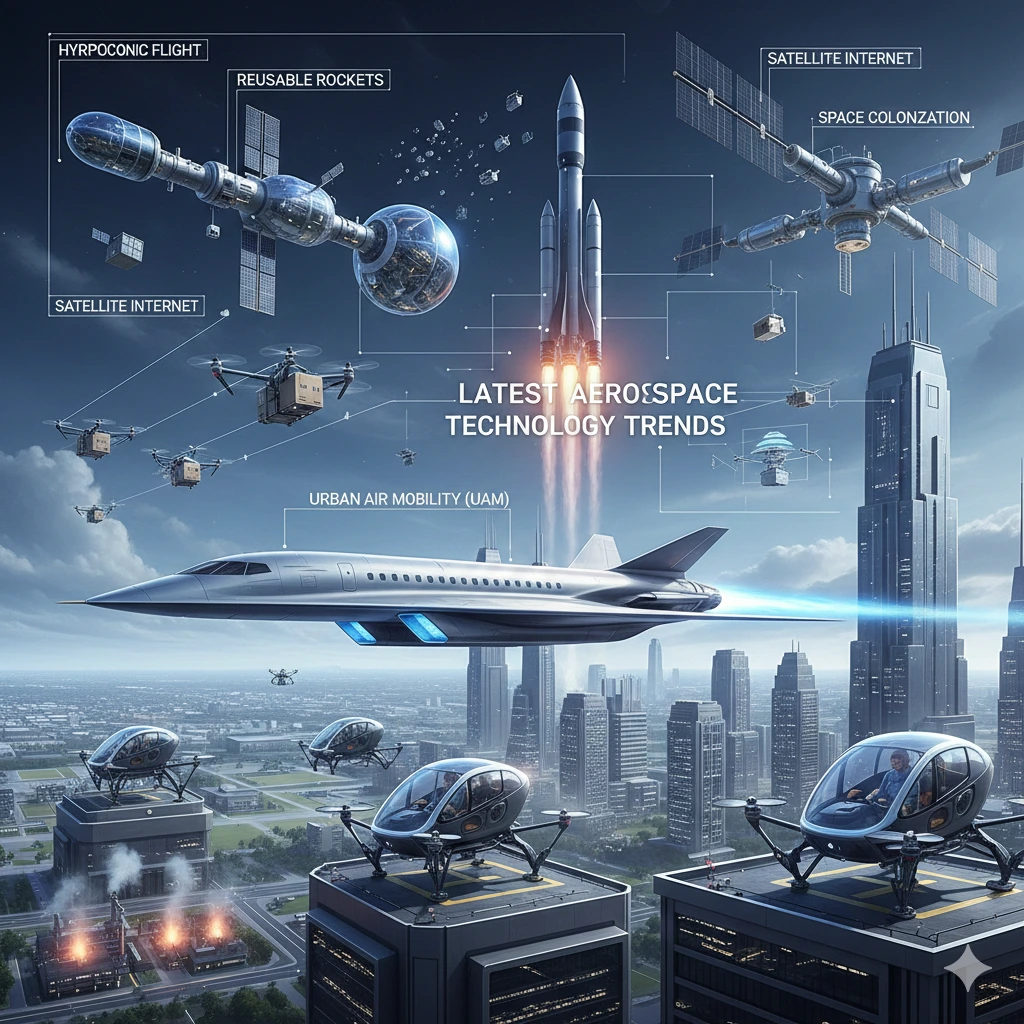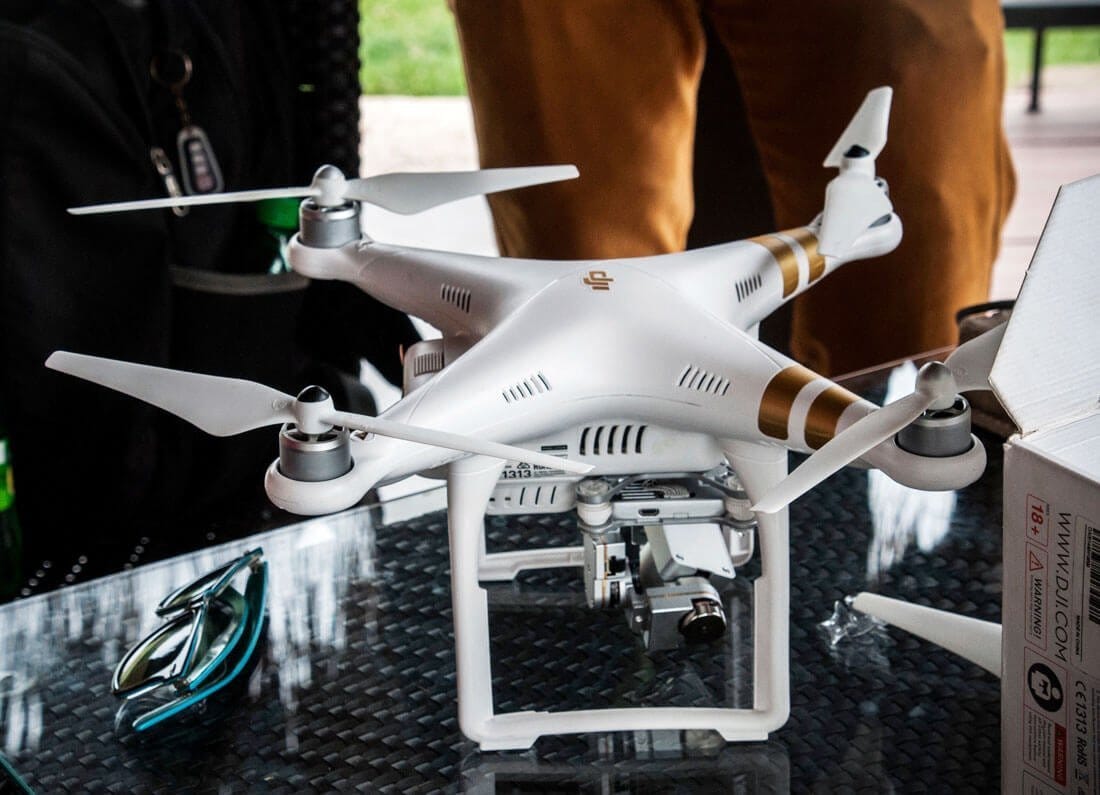Stay informed on the latest aerospace technology trends, featuring breakthroughs in engineering, automation, and eco-friendly solutions for the aviation industry.
🚀 The Edge of Flight: Latest Aerospace Technology Trends
The aerospace industry is undergoing a revolutionary transformation, driven by an urgent need for sustainability, the accelerating commercialization of space, and the pervasive integration of digital technologies. These trends are reshaping everything from how we travel to how we explore the universe.
🌎 Sustainable and Green Aviation: Latest Aerospace Technology Trends
Sustainability has become a core driver of innovation, pushing the sector towards greener operations and a reduced carbon footprint.
- Sustainable Aviation Fuels (SAF): A major focus is shifting away from fossil fuels. Airlines and manufacturers are heavily investing in SAF—derived from sources like used cooking oil, agricultural waste, and algae—to significantly lower lifecycle carbon emissions.
- Electric and Hybrid Propulsion: The race is on to develop efficient electric and hybrid-electric aircraft. While all-electric battery solutions for large commercial jets face significant energy density challenges, hybrid systems and smaller aircraft like Electric Vertical Takeoff and Landing (eVTOL) vehicles are rapidly advancing towards certification for Urban Air Mobility (UAM).
- Advanced Materials and Designs: The use of lightweight composites and recycled/bio-additive materials in manufacturing and cabin interiors is on the rise to enhance fuel efficiency. New aircraft designs are moving beyond the traditional tube-and-wing shape to optimize aerodynamics.
🛰️ The New Space Economy and Exploration: Latest Aerospace Technology Trends
The space sector is booming, largely fueled by private enterprises, creating a dynamic new economy and accelerating exploration goals.
- Commercial Spaceflight: Companies like SpaceX and Blue Origin are driving down the cost of access to space through reusable rocket technology. This has led to a surge in commercial satellite launches, private missions to orbit, and the early stages of space tourism.
- Satellite Constellations: The deployment of large-scale low Earth orbit (LEO) satellite constellations is dramatically improving global connectivity, but it also creates challenges regarding space debris and orbital traffic management.
- Deep Space Missions: Government programs, notably NASA’s Artemis Program, are focused on returning humans to the Moon and establishing a sustainable presence as a stepping stone for future crewed missions to Mars. Aerospace engineers are innovating life support systems, habitats, and advanced propulsion for these deep-space objectives.
💻 Digital Transformation and Advanced Manufacturing: Latest Aerospace Technology Trends
The integration of computing power and innovative production methods is fundamentally changing how aircraft and spacecraft are designed, built, and maintained.
- Artificial Intelligence (AI) and Automation: AI is being integrated across the value chain:
- Flight Optimization: AI-driven systems are being used to optimize flight trajectories in real-time to reduce fuel consumption.
- Predictive Maintenance: AI and machine learning analyze data from Structural Health Monitoring (SHM) sensors to predict component failures before they occur, reducing downtime.
- Autonomous Systems: Autonomous flight is advancing rapidly, from sophisticated drones and UAVs to AI-assisted co-pilots in larger aircraft.
- Additive Manufacturing (3D Printing): 3D printing allows for the creation of incredibly complex, lightweight parts with minimal waste, leading to improved fuel efficiency and simplified supply chains. This is particularly valuable for producing intricate engine components and structures.
- Digital Twins and Simulation: Engineers are using digital twin technology—virtual replicas of physical aircraft or engines—in combination with Augmented and Virtual Reality (AR/VR) for real-time design collaboration, comprehensive testing, and immersive training simulations.
✈️ Next-Generation Air Travel: Latest Aerospace Technology Trends
Future air travel promises to be faster and more integrated into the urban environment.
- Hypersonic and Supersonic Flight: Companies are making significant strides in developing commercial supersonic jets and researching hypersonic flight (Mach 5+), which could drastically cut long-haul travel times. New engine and materials technology is key to overcoming challenges like noise and fuel efficiency.
- Urban and Regional Air Mobility (UAM/RAM): The vision of air taxis and small passenger drones (eVTOLs) operating within and between cities is moving closer to reality, with regulatory bodies working to establish frameworks for integrating these new vehicles into civilian airspace.
These trends highlight an industry in flux, prioritizing innovation that is not only powerful and efficient but also environmentally and economically sustainable. The next decade will see many of these cutting-edge technologies move from the drawing board into everyday reality.
🌱 The Technology and Policy Driving Sustainable Aviation Fuel (SAF): Latest Aerospace Technology Trends
Sustainable Aviation Fuel (SAF) is a crucial, near-term solution for decarbonizing the aerospace industry. It is a “drop-in” fuel—meaning it can be blended with conventional jet fuel without requiring modifications to existing aircraft engines or airport infrastructure. The key to its sustainability lies in its production from renewable or waste sources that absorb $\text{CO}_2$ during their lifecycle, resulting in a lifecycle carbon emission reduction of up to 80% or more compared to fossil jet fuel.
🔬 Key SAF Production Pathways: Latest Aerospace Technology Trends
The American Society for Testing and Materials (ASTM) has certified multiple pathways, with new ones continuously being developed. These pathways use different feedstocks (raw materials) to produce a synthetic kerosene (SK) that is blended with traditional jet fuel.
| Pathway Name (Acronym) | Primary Feedstock | Current Maturity/Status |
| Hydroprocessed Esters and Fatty Acids (HEFA) | Used cooking oil, animal fats, waste greases, and purpose-grown non-food oils (e.g., camelina, carinata). | Most Mature/Dominant. Currently the only pathway producing SAF at commercial scale. |
| Alcohol-to-Jet (AtJ) | Alcohols (ethanol or butanol) sourced from sugar/starch crops, agricultural residues, or municipal solid waste. | Rapidly Scaling. Converts alcohol intermediates into jet fuel. |
| Fischer-Tropsch (FT) SPK | Synthesis gas (syngas) derived from woody biomass, agricultural residues, or municipal solid waste. | Commercialized. Converts syngas into synthetic kerosene. |
| Power-to-Liquid (PtL) / E-SAF | Captured $\text{CO}_2$ (from industrial sources or direct air capture) combined with renewable hydrogen ($\text{H}_2$). | Emerging/High Potential. Offers the highest long-term reduction potential but is currently very expensive and energy-intensive. |
Crucial Insight: The biggest challenge for HEFA, the current leader, is the limited, sustainable supply of waste fats and oils, which drives the need for new feedstock innovations like cover crops and advanced synthetic routes.
📈 Latest Updates and Global Adoption (2024-2025): Latest Aerospace Technology Trends
The landscape for SAF is shifting rapidly from voluntary pledges to concrete regulatory action and significant investment.
1. Policy and Mandates
- Europe’s ReFuelEU Mandate: The policy officially took effect, mandating a minimum 2% SAF blend for all fuel uplifted at EU airports starting on January 1, 2025, with targets rising progressively to 70% by 2050. This creates guaranteed demand.
- US Policy Incentives: The Inflation Reduction Act (IRA) of 2022 offers significant tax credits tied to the lifecycle greenhouse gas (GHG) emissions of the fuel, incentivizing domestic SAF production and driving numerous new project announcements.
- APAC Action: The Asia-Pacific region, including Singapore, Japan, and Australia, is moving from aspiration to action, with Singapore setting a confirmed 1% SAF goal by 2026 and other countries launching major subsidy programs.
2. Production and Investment
- Scaling Capacity: Global SAF production is expected to double from 1 million metric tonnes (Mt) in 2024 to approximately 2 Mt in 2025, though this still represents less than 1% of total jet fuel demand.
- Major Producers: Established firms like Neste are expanding refinery capacity (e.g., in Singapore and Rotterdam), and major energy companies (like Shell and TotalEnergies) are reallocating capital to SAF projects.
- 100% SAF Flights: Regulatory efforts are advancing to certify the use of 100% unblended SAF in commercial aircraft by around 2030, a critical step to maximize carbon reduction benefits.
- e-SAF Focus: Significant capital is being invested in Power-to-Liquid (PtL), or e-SAF, projects because this pathway is feedstock-agnostic (using $\text{CO}_2$ and renewable $\text{H}_2$) and has the deepest long-term decarbonization potential.
The convergence of global policy mandates and private sector investment is accelerating SAF technology, turning it into the primary tool for aviation to achieve its net-zero $\text{CO}_2$ emissions target by 2050.
You can learn more about the production process in this video: How is SAF (Sustainable Aviation Fuel) made?
Also, read Eastern Signage 2025: Key Highlights and Event Focus


